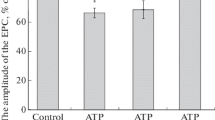Abstract
Electrophysiological investigation of the characteristics of ganglionic block by methylmercury (mHg) was carried out on the isolated superior cervical ganglion of the rabbit. A low concentration (5 μM) of mHg consistently produced a small increase in the amplitude of the compound action potential whereas an inhibitory effect was observed with higher concentrations (10–20 μM). The inhibitory effect was temperature-dependent and was not reversible by washing. Raising the external calcium concentration antagonized the inhibitory effect of mHg by markedly slowing down the progression of ganglionic block. The evidence indicates that the blocking effect of mHg is exerted principally on the presynaptic nerve terminals, and may be due to inhibition of acetylcholine release by interfering with the function of calcium at these terminals.
Similar content being viewed by others
References
Alkadhi KA, Taha MN (1980) Effect of methylmercuric chloride on the superior cervical ganglion of the rabbit. Fed Proc 39: 622
Bakir F, Domaluji SF, Amin-Zaki L, Murtadha M, Khalidi A, Al-Rawi NY, Tikriti S, Dhahir HI, Clarkson TW, Smith JC, Doherty RA (1973) Methylmercury poisoning in Iraq. Science 181: 230–241
Berlin M, Carlson J, Norseth T (1975) Dose-dependence of methylmercury metabolism. Arch Environ Health 30: 307–317
Brown DA, Kwiatkowsky D (1976) A note on the effect of dithiothreitol (DTT) on the depolarization of isolated sympathetic ganglia by carbachol and bromo-acetylcholine. Br J Pharmacol 56: 128–130
Chang LW (1977) Neurotoxic effects of mercury — a review. Environ Research 14: 329–373
Clarkson TW (1972) The pharmacology of mercury compounds. Ann Rev Pharmac 12: 375–406
Fehling C, Abdulla M, Brun A, Dictor M, Schütz A, Skerrving S (1975) Methylmercury poisoning in the rat: a combined neurological, chemical and histopathological study. Toxicol Appl Pharmacol 33: 27–37
Friberg L (1959) Studies on metabolism of mercuric chloride and methylmercury dicyandiamide. Arch Ind Health 20: 42–52
Harvey AM, MacIntosh FC (1940) Calcium and synaptic transmission in a sympathetic ganglion. J Physiol (London) 97: 408–416
Juang MS (1976a) Depression of frog muscle contraction by methylmercuric chloride and mercuric chloride. Toxicol Appl Pharmacol 35: 183–185
Juang MS (1976b) An electrophysiological study of the action of methylmercuric chloride and mercuric chloride on the sciatic nerve-sartorius muscle preparation of the frog. Toxicol Appl Pharmacol 37: 339–348
Juang MS, Yonemura K (1975) Increased spontaneous transmitter release from presynaptic nerve terminal by methylmercuric chloride. Nature (London) 256: 211–213
Karlin A (1969) Chemical modification of the active site of the acetylcholine receptor. J Gen Physiol 54: 245s-246s
Katz B, Miledi R (1965) The effect of temperature on the synaptic delay at the neuromuscular junction. J Physiol (Lond) 181: 656–670
Komalahiranaya A, Volle RL (1963) Alterations of transmission in sympathetic ganglia treated with a sulfhydryl-group inhibitor, N-ethylmaleimide (NEM). J Pharmacol Exp Ther 139: 304–311
Manalis RS, Cooper GP (1975) Evoked transmitter release increased by inorganic mercury at frog neuromuscular junction. Nature (London) 257: 690–691
Miyakawa T, Deshimaru M, Sumiyoshi S, Tersoka A, Udo N, Hattori E, Tetetsu L (1970) Experimental organic mercury poisoning, pathological changes in peripheral nerves. Acta Neuropathol (Berlin) 15: 45–55
Rang HP, Ritter JM (1971) The effect of disulfide bond reduction on the properties of cholinergic receptors in chick muscle. Mol Pharmacol 7: 620–631
Rustam H, Von Burg R, Amin-Zaki L, El-Hassani S (1975) Evidence for a neuromuscular disorder in methylmercury poisoning. Arch Environ Health 30: 190–195
Shrivastav BB, Brodwick MS, Narahashi T (1976) Methyl mercury: effects on electrical properties of squid axon membranes. Life Sci 18: 1077–1082
Somjen GG, Herman SP, Klein R (1973) Electrophysiology of methylmercury poisoning. J Pharmacol Exp Ther 186: 579–592
Taha MN, Alkadhi KA (1982) Effects of methylmercuric chloride on sympathetic preganglionic nerves. Arch Toxicol 50: 142–147
Tsubaki T, Shivakawa K, Hirota K, Kanbayashi K (1977) Neurological aspects of methyl-mercury poisoning in Niigata. In: Tsubaki T, Irukayama K (eds) Minamata Disease. Kodansha Ltd., Tokyo, Japan, pp 145–165
Author information
Authors and Affiliations
Rights and permissions
About this article
Cite this article
Alkadhi, K.A., Taha, M.N. Antagonism by calcium of the inhibitory effect of methylmercury on sympathetic ganglia. Arch Toxicol 51, 175–181 (1982). https://doi.org/10.1007/BF00302758
Received:
Issue Date:
DOI: https://doi.org/10.1007/BF00302758




